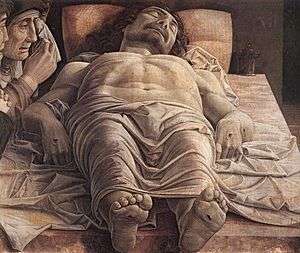Lamentation of Christ (Mantegna)
 | |
| Artist | Andrea Mantegna |
|---|---|
| Year | c. 1480 |
| Medium | Tempera on canvas |
| Dimensions | 68 cm × 81 cm (27 in × 32 in) |
| Location | Pinacoteca di Brera, Milan |
The Lamentation of Christ (also known as the Lamentation over the Dead Christ, or the Dead Christ and other variants) is a painting of about 1480 by the Italian Renaissance artist Andrea Mantegna. While the dating of the piece is debated, it was completed between 1475 and 1501, probably in the early 1480s.[1] It portrays the body Christ supine on a marble slab. He is watched over by the Virgin Mary and Saint John weeping for his death.
The theme of the Lamentation of Christ is common in medieval and Renaissance art, although this treatment, dating back to a subject known as the Anointing of Christ is unusual for the period. Most Lamentations show much more contact between the mourners and the body. Rich contrasts of light and shadow abound, infused by a profound sense of pathos. The realism and tragedy of the scene are enhanced by the violent perspective, which foreshortens and dramatizes the recumbent figure, stressing the anatomical details: in particular, Christ's thorax. The holes in Christ's hands and feet, as well as the faces of the two mourners, are portrayed without any concession to idealism or rhetoric. The sharply drawn drapery which covers the corpse contributes to the dramatic effect. The composition places the central focus of the image on Christ's genitals - an emphasis often found in figures of Jesus, especially as an infant, in this period, which has been related to a theological emphasis on the Humanity of Jesus by Leo Steinberg and others.
Mantegna presented both a harrowing study of a strongly foreshortened cadaver and an intensely poignant depiction of a biblical tragedy. This painting is one of many examples of the artist's mastery of perspective. At first glance, the painting seems to display an exact perspective. However, careful scrutiny reveals that Mantegna reduced the size of the figure's feet, which, as he must have known, would cover much of the body if properly represented.[2]
 | |
|
|
Mantegna probably made this painting for his personal funerary chapel. It was found by his sons in his studio after his death and sold off to pay debts. The painting is now in the Pinacoteca di Brera of Milan, Italy.
Notes
- ↑ Mantegna, Andrea. Web Gallery of Art. Retrieved June 14, 2009.
- ↑ Kleiner, Fred S. Gardner's Art Through the Ages, 13th edition.
- ↑ "Mantegna's Dead Christ". Smarthistory at Khan Academy. Retrieved May 9, 2013.
Sources
- La Grande Storia dell'Arte - Il Quattrocento, Il Sole 24 Ore, 2005
- Kleiner, Frank S. Gardner's Art Through the Ages, 13th Edition, 2008
- Manca, Joseph. Andrea Mantegna and the Italian Renaissance, 2006